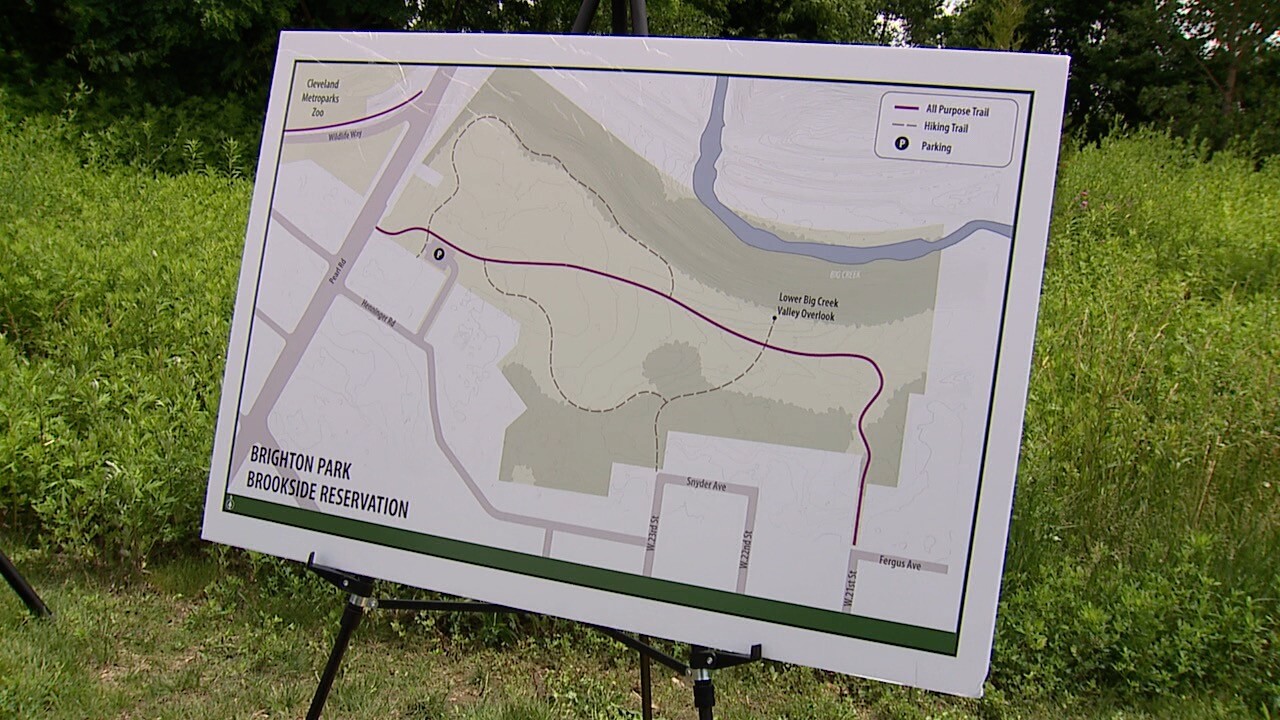CLEVELAND — A total makeover for a polluted piece of property in Cleveland's most populous neighborhood is complete as more than 100 people, including city officials, non-profit leaders and neighborhood residents took part in the ribbon-cutting at Brighton Park.
Located in the heart of Old Brooklyn, the 25-acre park, which includes meandering meadows, a scenic overlook of Big Creek and a mile of walking trails, was built on top of the former Henninger Landfill, a decades-old repository for construction and demolition debris.
Tuesday morning's ribbon cutting at the newly-minted park, which is part of the Cleveland Metroparks' Brookside Reservation, marks the end of a circuitous, 15-year process to turn the landfill into a landmark. Acquiring the property, environmental remediation and construction of the park required nearly a dozen different funding sources, including grants and donations from a litany of non-profits. The project was primarily spearheaded by the Old Brooklyn Community Development Corporation, Western Reserve Land Conservancy and the Cleveland Metroparks.
"It may be the most meaningful day of my public career. I played on this landfill as a kid," said Jim Rokakis, the vice president of Western Reserve Land Conservancy. "To be able to play a key role in the transforming it into a community asset, it doesn't get any better than that."
Rokakis said the former landfill site quickly became a passion project in his first years on the Cleveland City Council. However, as passionate as he was, the project was also a test of patience. There have been countless public meetings over the years and numerous instances of developers balking at redeveloping the site.

Amounting to roughly 28 acres, the property where Brighton Park now sits is located across Pearl Road from the Cleveland Metroparks Zoo and flanks Big Creek, one of the Cuyahoga River's biggest tributaries. For more than four decades, the area operated as a landfill for construction and demolition debris, including the remnants of Municipal Stadium, fill material from the I-71 construction project, as well as foundry sand from heavy industry. After the landfill ceased operations, it became a dumping ground for cars, tires, trash and other unsavory materials.
In 2006, the city of Cleveland, the Metroparks and Old Brooklyn CDC identified the property as a key acquisition for public greenspace. Two years later, it was included in the redevelopment and restoration plan for Lower Big Creek, which would be an important connector piece to the Towpath Trail.

In 2015, the Western Reserve Land Conservancy took the title of the former landfill and secured a Clean Ohio Conservation Fund grant. As part of the project, restoration work is planned for the lower portions of Big Creek in an effort to improve water quality and reduce pollution. Remediation of the site was completed in 2017 and in the years that followed, funding from nearly a dozen different sources was secured. Construction of the park began last summer.
"We look at old properties and we celebrate when we build brick-and-mortar kinds of things: condo developments, a row of townhouses," said Cleveland City Council President Kevin Kelley. "Indeed, that's good. But if you really think about what really represents urban renewal, this is better. This is a symbol of what we can do together."
"Forty-five thousand residents are now within minutes of this location, connecting to the Towpath Trail, connecting to the zoo. It's just wonderful to see this link really be part of this community," said Councilman Tony Brancatelli (Ward 13). "When I look at this particular landfill being transformed into, I think it's a model for what we can do reshape our neighborhoods and really add a lot more value to our neighborhoods."

Brighton Park will immediately help expand the footprint of Brookside Reservation, one of the Cleveland Metroparks' oldest parks. In 2020, the Cleveland Metroparks reported a record-setting 19.7 million visitors, fueled in part by the COVID-19 pandemic.
"It was the vision of connecting this back to the community. What had long been seen as kind of an eyesore is now one of the community's assets," said Brian Zimmerman, the CEO of Cleveland Metroparks.


